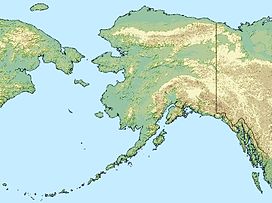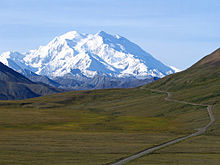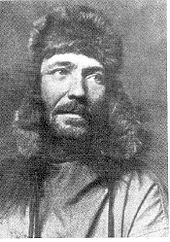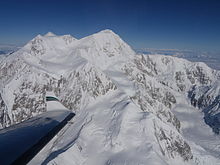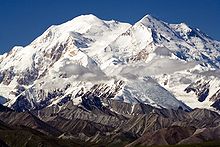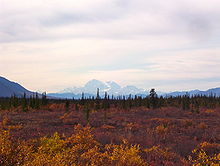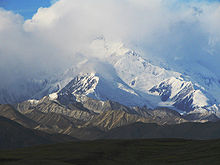- Mount McKinley
-
Mount McKinley Denali 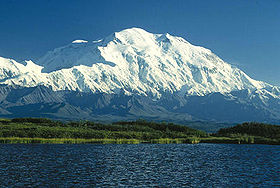
Mount McKinley from the north. Wonder Lake is in the foreground.Elevation 20,327 ft (6,196 m) NGVD 29[1] Prominence 20,156 ft (6,144 m) [1]
Ranked 3rdListing Seven summits
Ultra prominent peak
Nation's highest point
U.S. state highest pointLocation Denali National Park and Preserve, Alaska, USA Range Alaska Range Coordinates 63°04′10″N 151°00′27″W / 63.0695°N 151.0074°WCoordinates: 63°04′10″N 151°00′27″W / 63.0695°N 151.0074°W[2] Topo map USGS Mt. McKinley A-3 Climbing First ascent June 7, 1913 by
 Hudson Stuck
Hudson Stuck
 Harry Karstens
Harry Karstens
 Walter Harper
Walter Harper
 Robert Tatum
Robert TatumEasiest route West Buttress Route (glacier/snow climb) Mount McKinley or Denali (Koyukon Athabaskan for "The High One", Dghelaayce’e in Ahtna) in Alaska, United States is the highest mountain peak in North America and the United States, with a summit elevation of 20,320 feet (6,194 m) above sea level.[1] The CIA World Factbook lists its summit elevation as 6,198 metres (20,335 ft).[3] It is the centerpiece of Denali National Park and Preserve.
Contents
Geology and features
Mount McKinley is a granitic pluton. It has been uplifted by tectonic pressure while at the same time, erosion has stripped away the (somewhat softer) sedimentary rock above and around the mountain.
The forces that lifted Mount McKinley—the subduction of the Pacific plate beneath the North American plate—also raised great ranges across southern Alaska. As that huge sheet of ocean-floor rock plunges downward into the mantle, it shoves and crumples the continent into soaring mountains which include some of the most active volcanoes on the continent. Mount McKinley in particular is uplifted relative to the rocks around it because it is at the intersection of major active strike-slip faults (faults that move rocks laterally across the Earth's surface) which allow the deep buried rocks to be unroofed more rapidly compared to those around them.
Layout of the mountain
Mount McKinley has two significant summits: the South Summit is the higher one, while the North Summit has an elevation of 19,470 feet (5,934 m) and a prominence of approximately 1,320 feet (402 m). The North Summit is sometimes counted as a separate peak (see e.g., the List of United States fourteeners) and sometimes not; it is rarely climbed, except by those doing routes on the north side of the massif.
Five large glaciers flow off the slopes of the mountain. The Peters Glacier lies on the northwest side of the massif, while the Muldrow Glacier falls from its northeast slopes. Just to the east of the Muldrow, and abutting the eastern side of the massif, is the Traleika Glacier. The Ruth Glacier lies to the southeast of the mountain, and the Kahiltna Glacier leads up to the southwest side of the mountain.
 Mount Mckinley 3D.
Mount Mckinley 3D.
Naming
The Koyukon Athabaskan people who inhabit the area around the mountain referred to the peak as Dinale or Denali ("the high one" or "the great one"). In the late 1890s, a gold prospector named it "McKinley" as political support for then-president William McKinley. The Alaska Board of Geographic Names changed the name of the mountain to Denali, which is how it is referred to locally. However, a 1975 request by the Alaska state legislature to the United States Board on Geographic Names to do the same was blocked by Ohio congressman Ralph Regula, whose district includes McKinley's hometown. Members of the Ohio congressional delegation continue to protect the McKinley name, blocking attempts by the Alaska congressional delegation to get the Board of Geographic Names to change it to Denali. Thus, "Denali" is correct according to the Alaska state board, while "McKinley" is correct according to the national board.
History
The Koyukon Athabaskans are the first Native Americans with access to the flanks of the mountain (living in the Yukon, Tanana and Kuskokwim basins).[2] The historical first European sighting of Mount McKinley took place on May 6, 1794, when George Vancouver was surveying the Knik Arm of the Cook Inlet and mentioned “distant stupendous mountains” in his journal. The Russian explorer Lavrenty Zagoskin explored the Tanana and Kuskokwim rivers in 1843 and 1844 and was probably the first European to sight the mountain from the other side.[4]
William Dickey, a New Hampshire-born Seattleite who had been digging for gold in the sands of the Susitna River, wrote, after his return to the lower states, an account in the New York Sun that appeared on January 24, 1897.[5][dead link] His report drew attention with the sentence “We have no doubt that this peak is the highest in North America, and estimate that it is over 20,000 feet (6,100 m) high.” Until then 18,000-foot (5,500 m) Mount Saint Elias was believed to be the continent’s highest point (Mount Logan was still unknown and Mount St Elias’ height had been overestimated to beat Pico de Orizaba[citation needed]). Though later praised for his estimate, Dickey admitted that other prospector parties had also guessed the mountain to be over 20,000 feet (6,100 m).[6]
Climbing history
The first recorded attempt to climb Mount McKinley was by Judge James Wickersham in 1903, via the Peters Glacier and the North Face, now known as the Wickersham Wall. This route has tremendous avalanche danger and was not successfully climbed until 1963.
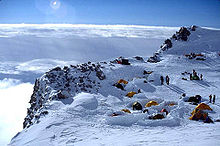 High camp (17,200 ft/5,200 m) of the West Buttress Route pioneered by Bradford Washburn, photographed in 2001
High camp (17,200 ft/5,200 m) of the West Buttress Route pioneered by Bradford Washburn, photographed in 2001
Famed explorer Dr. Frederick Cook claimed the first ascent of the mountain in 1906. His claim was regarded with some suspicion from the start, but was also widely believed. It was later proved false, with some crucial evidence provided by Bradford Washburn when he was sketched on a lower peak.
In 1910, four locals (Tom Lloyd, Peter Anderson, Billy Taylor, and Charles McGonagall), known as the Sourdough expedition, attempted McKinley, despite a complete lack of climbing experience. They spent approximately three months on the mountain. However, their purported summit day was impressive: carrying a bag of doughnuts, each a thermos of hot chocolate, and a 14-foot (4.2 m) spruce pole, two of them reached the North Summit, the lower of the two, and erected the pole near the top. According to them, they took a total of 18 hours – a record that has yet to be beat(as of 2006). No one believed their success (partly due to false claims that they had climbed both summits) until the true first ascent, in 1913.
In 1912, the Parker-Browne expedition nearly reached the summit, turning back within just a few hundred yards of it due to harsh weather. In fact, that probably saved their lives, as a powerful earthquake shattered the glacier they ascended hours after they safely left it.
The first ascent of the main summit of McKinley came on June 7, 1913, by a party led by Hudson Stuck. The first man to reach the summit was Walter Harper, an Alaska Native. Harry Karstens and Robert Tatum also made the summit. Tatum later commented, "The view from the top of Mount McKinley is like looking out the windows of Heaven!"[7] They ascended the Muldrow Glacier route pioneered by the earlier expeditions, which is still often climbed today. Stuck confirmed, via binoculars, the presence of a large pole near the North Summit; this report confirmed the Sourdough ascent, and today it is widely believed that the Sourdoughs did succeed on the North Summit. However, the pole was never seen before or since, so there is still some doubt. Stuck also discovered that the Parker-Browne party were only about 200 feet (61 m) of elevation short of the true summit when they turned back.
See the timeline below for more important events in Mount McKinley's climbing history.
The mountain is regularly climbed today; in 2003, around 58% of climbers reached the top. But by 2003, the mountain had claimed the lives of nearly 100 mountaineers over time.[8] The vast majority of climbers use the West Buttress Route, pioneered in 1951 by Bradford Washburn, after an extensive aerial photographic analysis of the mountain. Climbers typically take two to four weeks to ascend the mountain.
Timeline
- 1896–1902: Surveys by Robert Muldrow, George Eldridge, Alfred Brooks.
- 1903: First attempt, by Judge James Wickersham.
- 1906: Frederick Cook falsely claims the first ascent of McKinley.
- 1910: The Sourdoughs ascend the North Summit.
- 1912: The Parker-Browne attempt almost reaches the South Summit.
- 1913: First ascent by Hudson Stuck, Walter Harper, Harry Karstens, Robert Tatum.
- 1932: Second ascent, by Alfred Lindley, Harry Liek, Grant Pearson, Erling Strom. (Both peaks were climbed.)
- 1947: Barbara Washburn becomes the first woman to reach the summit as her husband Bradford Washburn becomes the first to summit twice.
- 1951: First ascent of the West Buttress Route, led by Bradford Washburn.
- 1954: First ascent of the very long South Buttress Route.
- 1959: First ascent of the West Rib, now a popular, mildly technical route to the summit.
- 1961: First ascent of the Cassin Ridge, the best-known technical route on the mountain. This was a major landmark in Alaskan climbing.
- 1963: Two teams make first ascents of two different routes on the Wickersham Wall.
- 1967: First winter ascent, via the West Buttress, by Dave Johnston, Art Davidson and Ray Genet.
- 1967: Seven members of Joe Wilcox's twelve-man expedition perish, while stranded for ten days near the summit, in what has been described as the worst storm on record. Up to that time, this was the third worst disaster in mountaineering history in terms of lives lost.[9]
- 1970: First solo ascent by Naomi Uemura.
- 1972: Sylvain Saudan, "Skier of the Impossible", skis down the sheer southwest face, conquered for the first time by skier or climber.
- 1976: First solo ascent of the Cassin Ridge by Charlie Fowler, a climb "ahead of its time".[10]
- 1979: First ascent by dog team achieved by Susan Butcher, Ray Genet, Brian Okonek, Joe Redington, Sr., and Robert Stapleton.[11]
- 1984: Uemura returns to make the first winter solo ascent, but dies after summitting. Tono Križo, František Korl and Blažej Adam from the Slovak Mountaineering Association climb a very direct route to the summit, now known as the Slovak Route, on the south face of the mountain, to the right of the Cassin Ridge.[12]
- 1988: First solo winter ascent with safe return, by Vern Tejas.
- 1997: First successful ascent up the West Fork of Traleika Glacier up to Karstens Ridge beneath Browne Tower. This path was named the "Butte Direct" by the two climbers Jim Wilson and Jim Blow.[13][14]
Weather station
The Alpine Club installed a meteorological station on a ridge near the summit of Denali at an altitude of 5,710 m in 1990. In 1998, this weather station was donated to the International Arctic Research Center at the University of Alaska Fairbanks. In June 2002, a weather station was placed at the 19,000-foot (5,800 m) level. This weather station was designed to transmit data in real-time for use by the climbing public and the science community. Since its establishment, annual upgrades to the equipment have been performed with instrumentation custom built for the extreme weather and altitude conditions. This weather station is one of only two weather stations in the world located above 18,000 feet (5,500 m).
The weather station recorded temperatures as low as −75.5 °F (−59.7 °C) on December 1, 2003. On the previous day, November 30, 2003, a temperature of −74.4 °F (−59.1 °C) combined with a wind speed of 18.4 miles per hour to produce a North American record windchill of −118.1 °F (−83.4 °C).
Even in July, temperatures as low as −22.9 °F (−30.5 °C) and windchills as low as −59.2 °F (−50.7 °C) have been recorded by this weather station.
Historical record
The mountain is characterized by extremely cold weather. Temperatures as low as −75.5 °F (−59.7 °C) and windchills as low as −118.1 °F (−83.4 °C) have been recorded by an automated weather station located at 18,700 feet (5,700 m). According to the National Park Service, in 1932 the Liek-Lindley expedition recovered a self-recording minimum thermometer left near Browne's Tower, at about 15,000 feet (4,600 m), on Mount McKinley by the Stuck-Karstens party in 1913. The spirit thermometer was calibrated down to 95 °F below zero and the lowest recorded temperature was below that point. Harry J. Liek took the thermometer back to Washington, D.C. where it was tested by the United States Weather Bureau and found to be accurate. The lowest temperature that it had recorded was found to be approximately −100 °F (−73 °C).
Subpeaks and nearby mountains
Besides the North Summit mentioned above, other less significant features on the massif which are sometimes included as separate peaks are:
- South Buttress, 15,885 feet (4,842 m); mean prominence = 335 feet (102 m)
- East Buttress high point, 14,730 feet (4,490 m); mean prominence = 380 feet (116 m)
- East Buttress, most topographically prominent point, 14,650 feet (4,465 m); mean prominence = 600 feet (183 m)
- Browne Tower, 14,530 feet (4,429 m); mean prominence = 75 feet (23 m)
None of these peaks are usually regarded as worthwhile objectives in their own right; however they often appear on lists of the highest peaks of the United States. (Only one appears on the List of United States Fourteeners on Wikipedia.)
Nearby important peaks include:
See also
- Mountain peaks of North America
- Mountain peaks of the United States
- Mountain peaks of Alaska
- Table of the highest major summits of North America
- Table of the ultra-prominent summits of North America
- Table of the most isolated major summits of North America
- Highest mountain peaks
Notes
- ^ a b c "Mount McKinley, Alaska". Peakbagger.com. http://www.peakbagger.com/peak.aspx?pid=271. Retrieved 2010-02-01.
- ^ a b "Mount McKinley". Geographic Names Information System, U.S. Geological Survey. http://geonames.usgs.gov/pls/gnispublic/f?p=gnispq:3:::NO::P3_FID:1414314. Retrieved 2010-01-20.
- ^ United States entry at The World Factbook. Retrieved 2010-09-25.
- ^ Beckey, Fred. Mount McKinley: Icy Crown of North America Mount McKinley: Icy Crown of North America. ISBN 0-89886-646-4. http://books.google.com/books?hl=en&id=w48sXjjEWbwC&dq=Mount+McKinley:+Icy+Crown+of+North+America Mount McKinley: Icy Crown of North America. The Mountaineers Books 1993, paper 1999.
- ^ "Mount McKinley Name Change Gets New Wave of Support". Fairbanks Daily News-Miner. 2009-02-22. http://newsminer.com/news/2009/feb/22/mount-mckinley-name-change-gets-new-wave-support/.[dead link]
- ^ Sherwonit, Bill. Denali: A Literary Anthology. Seattle: The Mountaineers Books. ISBN 0-89886-710-X. See, particularly, chapter 4 (pages 52–61): "Discoveries in Alaska", 1897, by William A. Dickey.
- ^ Coombs, Colby; Washburn, Bradford (1997). Denali's West Buttress: A Climber's Guide to Mount McKinley's Classic Route. Seattle: The Mountaineers Books. ISBN 978-0898865165.
- ^ Glickman, Joe (2003-08-24). "Man Against the Great One". New York Times. http://query.nytimes.com/gst/fullpage.html?res=9C0DE5DC1439F937A1575BC0A9659C8B63&sec=travel&pagewanted=2. Retrieved 2010-09-25.
- ^ Tabor, James M. (2007). Forever on the Mountain: The Truth Behind One of Mountaineering's Most Controversial and Mysterious Disasters. W. W. Norton. ISBN 0-393-06174-4. (describing the 1967 tragedy of the Wilcox team)
- ^ supertopo.com [1]
- ^ "Historical Timeline". Denali National Park and Preserve. National Park Service. http://www.nps.gov/dena/planyourvisit/climbinghistory.htm. Retrieved 2010-09-25.
- ^ American Alpine Journal (Golden, Colorado: American Alpine Club) 26 (58): 174. 1985. ISSN 0065-6925.
- ^ American Alpine Journal (Golden, Colorado: American Alpine Club) 40 (72): 117–118. 1998. ISSN 0065-6925.
- ^ Secor, R. J. (1998). Denali Climbing Guide. Mechanicsburg, Pennsylvania: Stackpole Books. ISBN 0-8117-2717-3.
References
- Art Davidson, Minus 148°: First Winter Ascent of Mt. McKinley, 7th ed. (The Mountaineers Books, 2004) ISBN 0-89886-687-1
- Kaye, G. D., Using GIS to estimate the total volume of Mauna Loa Volcano, Hawaii, 98th Annual Meeting, Geological Society of America, (2002).
- Dow Scoggins, Discovering Denali
- Hudson Stuck, D.D., Archdeacon of the Yukon, The Ascent of Denali, The 1913 Expedition that First Conquered Mt. McKinley, ((reprinted by) Wolfe Publishing Co., 1988) ISBN 0-935632-69-7
- Bradford Washburn et al., Mount McKinley: The Conquest of Denali (Harry N. Abrams, Inc., 1991) ISBN 0-8109-3611-9
- Jonathan Waterman, High Alaska, AAC Press, 1988.
- Jonathan Waterman, In the Shadow of Denali: Life and Death on Alaska's Mt. McKinley (1994)++
- A Study of Accidents on Mount McKinley 1903-1990 (American Alpine Club, 1991)
External links
- Mt. McKinley Weather Station
- SummitPost: Photos
- PhotoMountains: High resolution aerial photographs of Denali climbing routes
- NOVA: Deadly Ascent
- H.R. 198: A bill to provide for the retention of the name of Mount McKinley (introduced to the 110th Congress by Rep. Regula)
- Timeline of Denali climbing history, National Park Service
- Travel The Whole World Denali 2009 Denali Trip Report - 75+ Photos
- Wilson, Rodman, William J. Mills, Jr., Donald R. Rogers and Michael T. Propst, "Death on Denali: Fatalities Among Climbers in Mount McKinley National Park From 1903 to 1976—Analysis of Injuries, Illnesses and Rescues in 1976," Western Journal of Medicine, 1978 June; 128(6): 471–476.
- Rodway, George W., "Paul Crews' "Accident on Mount McKinley"—A Commentary," Wilderness and Environmental Medicine: Vol. 14 (2003), No. 1, pp. 33–38.
- Freedman, Lew,"Dangerous Steps: Vernon Tejas and the Solo Winter Ascent of Mount McKinley", Stackpole, 1990.
U.S. State Highest Natural Points Alabama • Alaska • Arizona • Arkansas • California • Colorado • Connecticut • Delaware • Florida • Georgia • Hawaii • Idaho • Illinois • Indiana • Iowa • Kansas • Kentucky • Louisiana • Maine • Maryland • Massachusetts • Michigan • Minnesota • Mississippi • Missouri • Montana • Nebraska • Nevada • New Hampshire • New Jersey • New Mexico • New York • North Carolina • North Dakota • Ohio • Oklahoma • Oregon • Pennsylvania • Rhode Island • South Carolina • South Dakota • Tennessee • Texas • Utah • Vermont • Virginia • Washington • West Virginia • Wisconsin • Wyoming
Seven Summits Asia - Everest (8,848 m/29,029 ft)
South America - Aconcagua (6,962 m/22,841 ft)
North America - Mount McKinley (6,198 m/20,335 ft)
Africa - Kilimanjaro (5,893 m/19,334 ft)
Europe - Elbrus (5,642 m/18,510 ft)
- or Mont Blanc (4,810 m/15,781 ft)
Antarctica - Vinson Massif (4,892 m/16,050 ft)
Oceania - Puncak Jaya (4,884 m/16,024 ft)
- or Mount Wilhelm (4,509 m/14,793 ft)
- or Mount Kosciuszko (2,228 m/7,310 ft)
Categories:- Mount McKinley
- Alaska Range
- Mountains of Alaska
- Seven Summits
- United States National Park high points
- Sacred mountains
- Landforms of Denali Borough, Alaska
- Denali National Park and Preserve
- Religious places of the indigenous peoples of North America
- Highest points of U.S. states
Wikimedia Foundation. 2010.

